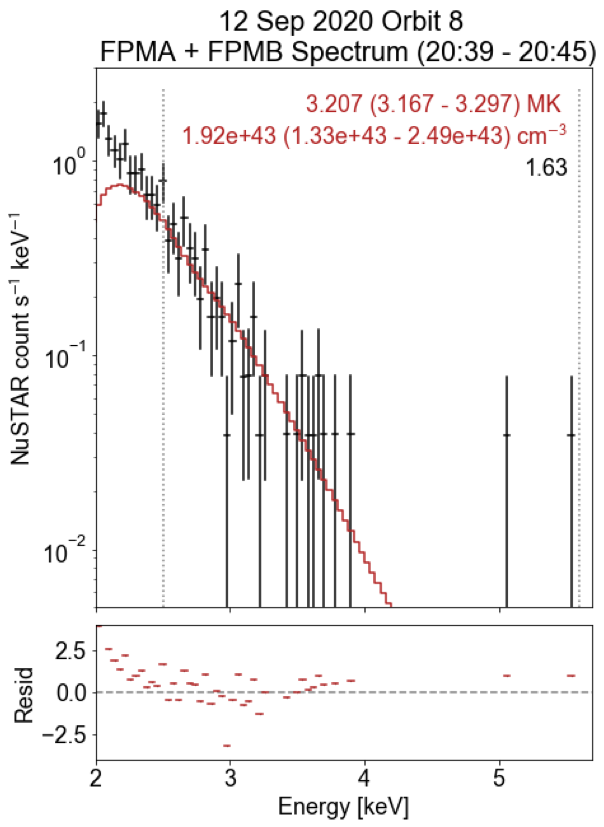Quick sanity check: are NuSTAR response functions the same?¶
/Users/wheatley/Documents/Solar/NuStar/specfiles/nu80610208001A06_chu12_N_sr_orbit8_2039_2042.arf /Users/wheatley/Documents/Solar/NuStar/specfiles/nu80610208001A06_chu12_N_sr_orbit8_2039_2042.rmf /Users/wheatley/Documents/Solar/NuStar/specfiles/nu80610208001B06_chu12_N_sr_orbit8_2039_2042.arf /Users/wheatley/Documents/Solar/NuStar/specfiles/nu80610208001B06_chu12_N_sr_orbit8_2039_2042.rmf /Users/wheatley/Documents/Solar/NuStar/specfiles/nu80610208001A06_chu12_N_sr_orbit8_2037_2050.arf /Users/wheatley/Documents/Solar/NuStar/specfiles/nu80610208001A06_chu12_N_sr_orbit8_2037_2050.rmf /Users/wheatley/Documents/Solar/NuStar/specfiles/nu80610208001B06_chu12_N_sr_orbit8_2037_2050.arf /Users/wheatley/Documents/Solar/NuStar/specfiles/nu80610208001B06_chu12_N_sr_orbit8_2037_2050.rmf /Users/wheatley/Documents/Solar/NuStar/specfiles/nu80610208001A06_chu12_N_sr_orbit8_2039_2045.arf /Users/wheatley/Documents/Solar/NuStar/specfiles/nu80610208001A06_chu12_N_sr_orbit8_2039_2045.rmf /Users/wheatley/Documents/Solar/NuStar/specfiles/nu80610208001B06_chu12_N_sr_orbit8_2039_2045.arf /Users/wheatley/Documents/Solar/NuStar/specfiles/nu80610208001B06_chu12_N_sr_orbit8_2039_2045.rmf
identical for A and B over the given time ranges
Find the best parameters¶
aia_contours=[75,80,85] #also no large correlation
xrt_submap_radii=[4,7,10] #nustar radii no effect really
xrt_facs=[1,1.5,2,2.5] #multiplicative factor for data
nustar_facs=[.5,1,1.5,2]
nustar_areas=['AIA','XRT'] #which instrument does NuSTAR take the area measurement from
min_errs=[.1,.15,.2]
#initial_weightvals=['guess','loci_min',6.5] #identical results with 'guess' and 6
bpdict['timerange']=s1tr
best_dem=joint_DEM(**bpdict, tstart=tstart,tend=tend)
bdf=best_dem.run_from_inputs()
all maps same dimensions
all maps same dimensions
all maps same dimensions
all maps same dimensions
all maps same dimensions
all maps same dimensions
not transposed
nustar cutout coords: <SkyCoord (Helioprojective: obstime=2020-09-12 20:39:08.832000, rsun=695508000.0 m, observer=<HeliographicStonyhurst Coordinate (obstime=2020-09-12 20:39:08.832000): (lon, lat, radius) in (deg, deg, m)
(0., 7.22963878, 1.50532105e+11)>): (Tx, Ty) in arcsec
(-963.75808695, 147.39076468)> <SkyCoord (Helioprojective: obstime=2020-09-12 20:39:08.832000, rsun=695508000.0 m, observer=<HeliographicStonyhurst Coordinate (obstime=2020-09-12 20:39:08.832000): (lon, lat, radius) in (deg, deg, m)
(0., 7.22963878, 1.50532105e+11)>): (Tx, Ty) in arcsec
(-853.75808695, 257.39076468)>
[3.69424930e+00 5.18546849e+01 6.57783664e+02 1.16438373e+03
5.18235735e+02 2.92784569e+01 9.85055542e+00 2.12063981e-01]
Input data and errors:
94 : 3.69 2.98 81 %
131 : 51.85 10.23 20 %
171 : 657.78 71.18 11 %
193 : 1164.38 121.16 10 %
211 : 518.24 56.06 11 %
335 : 29.28 5.18 18 %
Be-Thin : 19.70 3.94 20 %
NuSTAR 2.5-3.5 keV : 0.42 0.08 20 %
chisq: 1.013632
AIA DN_reg/DN_in ratio: 0.8464033483586682
Xray DN_reg/DN_in ratio: 0.9969143829711613
bdf[kkeys]
| aia_area | aia_contour | chisq | nustar_fac | xrt_area | xrt_fac | xrt_submap_radius | aia_ratio | xray_ratio | |
|---|---|---|---|---|---|---|---|---|---|
| 0 | 1.916528e+16 | 75.0 | 1.013632 | 2.0 | 8.110882e+17 | 2.0 | 7.0 | 0.846403 | 0.996914 |
Does this make sense? How different is it if we take areas (AIA, XRT) close to equal?¶
(these results were using the longest time range, so that might explain why they match up poorly compared to the ones using the shorter peak timerange)
#make the area actually equal...
ea_dem=joint_DEM(**bpdict,tstart=tstart,tend=tend)
ea_dem.xrt_submap_radius=3
#ea_dem.xrt_max=True
ea_dem.aia_contour=40
ea_dem.xrt_fac=1
ea_dem.nustar_fac=1
edf=ea_dem.run_from_inputs()
edf[['aia_area','xrt_area']]
all maps same dimensions
all maps same dimensions
all maps same dimensions
all maps same dimensions
all maps same dimensions
all maps same dimensions
not transposed
nustar cutout coords: <SkyCoord (Helioprojective: obstime=2020-09-12 20:39:08.832000, rsun=695508000.0 m, observer=<HeliographicStonyhurst Coordinate (obstime=2020-09-12 20:39:08.832000): (lon, lat, radius) in (deg, deg, m)
(0., 7.22963878, 1.50532105e+11)>): (Tx, Ty) in arcsec
(-963.75808695, 147.39076468)> <SkyCoord (Helioprojective: obstime=2020-09-12 20:39:08.832000, rsun=695508000.0 m, observer=<HeliographicStonyhurst Coordinate (obstime=2020-09-12 20:39:08.832000): (lon, lat, radius) in (deg, deg, m)
(0., 7.22963878, 1.50532105e+11)>): (Tx, Ty) in arcsec
(-853.75808695, 257.39076468)>
[3.14526019e+00 3.93592595e+01 5.90691413e+02 9.13980512e+02
3.29642496e+02 1.96708476e+01 2.60899048e+01 2.12063981e-01]
Input data and errors:
94 : 3.15 2.78 88 %
131 : 39.36 8.66 22 %
171 : 590.69 64.45 11 %
193 : 913.98 96.09 11 %
211 : 329.64 37.12 11 %
335 : 19.67 4.08 21 %
Be-Thin : 26.09 5.22 20 %
NuSTAR 2.5-3.5 keV : 0.21 0.04 20 %
chisq: 23.494525
AIA DN_reg/DN_in ratio: 0.22670329279597948
Xray DN_reg/DN_in ratio: 0.532984602173606
| aia_area | xrt_area | |
|---|---|---|
| 0 | 1.609883e+17 | 1.802418e+17 |
<matplotlib.image.AxesImage at 0x7fc4473a10b8>
Preflare DEM¶
using counts from images - for publication, use counts from .pha files (need Sarah to generate them for given timerange)
X-Ray Peak DEM¶
using counts from images - for publication, use counts from .pha files (need Sarah to generate them for given timerange)
AIA Peak DEM¶
using counts from images - for publication, use counts from .pha files (need Sarah to generate them for given timerange)
DEM at selected times - 'best' parameters¶
bpdict
{'aia_contour': 75.0,
'nustar_fac': 2.0,
'timerange': ['2020-09-12T20:39:00', '2020-09-12T20:42:00'],
'xrt_fac': 2.0,
'xrt_submap_radius': 7.0}
DEM at selected times - similar area AIA & XRT¶
eadict
{'aia_contour': 40.0,
'nustar_fac': 1.0,
'xrt_fac': 1.0,
'xrt_submap_radius': 3.0}


